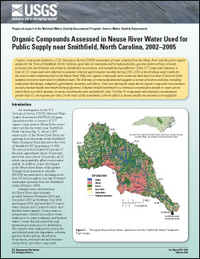Organic compounds studied in a U.S. Geological Survey (USGS) assessment of water samples from the Neuse River and the public supply system for the Town of Smithfield, North Carolina, generally are manmade and include pesticides, gasoline hydrocarbons, solvents, personal-care and domestic-use products, disinfection by-products, and manufacturing additives. Of the 277 compounds assessed, a total of 113 compounds were detected in samples collected approximately monthly during 2002–2005 at the drinking-water intake for the town's water-treatment plant on the Neuse River. Fifty-two organic compounds were commonly detected (in at least 20 percent of the samples) in source water and (or) finished water. The diversity of compounds detected suggests a variety of sources and uses, including wastewater discharges, industrial, agricultural, domestic, and others. Only once during the study did an organic compound concentration exceed a human-health benchmark (benzo[a]pyrene). A human-health benchmark is a chemical concentration specific to water above which there is a risk to humans, however, benchmarks were available for only 18 of the 42 compounds with detected concentrations greater than 0.1 micrograms per liter. On the basis of this assessment, adverse effects to human health are assumed to be negligible.


